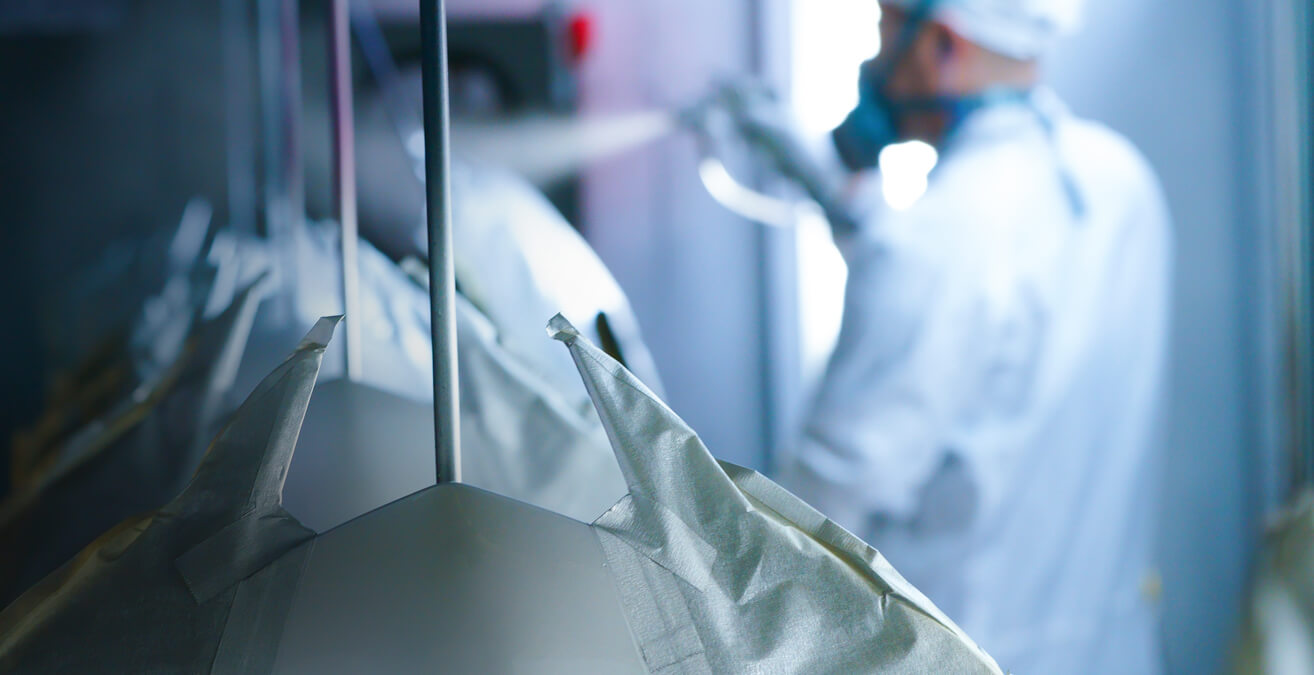Why We Continue Passing on Our Aesthetics and Handwork in an Automated Paint Shop
Our painting robots have both right and left hands; the right holds the spray gun while the left hand grips the object to be painted. Both move deftly and with care as paint is sprayed on with surprising speed and precision.
At the paint shops for Yamaha motorcycles manufactured in Japan, the various techniques honed by craftsmen of paintwork are faithfully reproduced by robots in an almost completely automated process. However, this doesn’t mean that Yamaha has removed the techniques and trained sense of paintwork masters from the equation outright. Although automation continues to change the way things are done in the paint shop, a small space akin to a craftsman’s atelier remains, one exclusively for hand spray painting. Why? As machines become more and more capable, why do we insist on still painting parts by hand and ensuring the requisite skills are passed on? The answers to these questions lie in the atelier.
A Slow Sway Like a Swimming Fish
Metallic paint is paint mixed with tiny metal flakes and produces a shine and depth that makes contours stand out more prominently. Yamaha motorcycle color schemes using this type of paint include Deep Purplish Metallic C (the blue in Yamaha Racing Blue) and Matte Grey Metallic 3 (the gray in Night Fluo). Chassis adorned with metallic paint sparkle with a metallic sheen that gives the motorcycle’s finish an even more high-end look and feel.
“When we’re spraying something with it, it feels like the tiny bits of metal foil are randomly swimming about ever so slowly in the viscous paint,” says one craftsman when describing the painting process.
To further enhance the radiance of the painted surface, the tiny bits of thin metal foil must be laid down neatly and evenly over the entire part or product. Conversely, if the flakes are unevenly dispersed, the finish becomes dark and flat. Using short, smooth, back-and-forth wrist strokes and varying the angles and tempo with the paint gun, the craftsman steadily lays down the tiny “fish” swimming in the paint. How can one tell if it has been done well or not? “Those who can tell will know when it’s been done right. And that’s how it should be,” he says.
Once in the hands of their proud owners, every Yamaha motorcycle sparkles brilliantly in the sunlight.

Bringing the Eyes and Touch of a Craftsman to Robots
In one corner of the paint shop remains an atelier for the craftsmen. In addition to painting select mass-produced parts and limited production parts, this is also where test painting is done for new models in development. It is a fact that mass-production painting is increasingly performed by robots, but when it comes to working out the details with the designers and finalizing the specs to create a product’s air and appearance, the parts are still sprayed or painted with the hands of craftsmen, just as it has always been.
The robots are taught the proper steps and techniques carefully refined by Yamaha’s painting masters and they then reproduce the movements quickly and repetitively. The extensive teaching program is loaded into the robots not by IT specialists, but by employees with long years of hand-painting experience on the production floor. “We don’t paint with the numbers. We paint using the senses we’ve sharpened over time,” they say. “Being able to notice things like the way the paint is adhering or settling is something only those who have spray-painted by hand for many years have acquired.”
And it is that sense—the eyes and touch of a master—that they are imparting to the robots.

“Scan the Skin”: The Eyes and Aesthetic Sense of a Master Painter
At Yamaha’s paint shop, those who have the skills and experience to appropriately check and evaluate a painted finish are said to have the ability to “scan the skin.”
“The ability to scan the skin comes from years of experience wielding a spray gun,” says one inspector. “That’s why the final visual inspection of paintwork is entrusted to those who built their resume of experience right here in the paint shop. Parts that pass inspection are sent as they are to the customer, so while this is a heavy responsibility, it’s also one in which we take great pride.”
Why, however, did Yamaha elect to keep this atelier for hand-spraying intact and to keep passing down these skills? For example, paint makers evaluate their trial paints with hand-spraying, but when those paints are sprayed by robots, the subtle nuances of the paint tones and textures change ever so slightly. So, the only way to ascertain the true qualities and potential of a paint is to hand-spray it. In addition, the Iwata Main Factory in Japan serves as the “mother factory” for Yamaha’s production facilities around the world, and at these factories overseas, most of the painting is still done by hand.
“Training new craftsmen at production facilities in other countries is another important mission of the Iwata Main Factory at Yamaha headquarters, and it’s a role entrusted to craftsmen from Japan.”
The sunburst paint scheme on the limited SR400 40th Anniversary Edition was also the work of these craftsmen. “We can actually get the robots to do something close to sunburst-style painting,” one painter admits. “But it’s not a genuine sunburst paintjob. As long as Yamaha remains a brand that values design excellence and takes pride in its paintwork, I’m certain the skills of craftsmen will continue to be needed, and passing on these skills is a tradition that will never end.”








